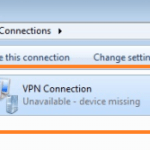If you try to setup a new VPN connection on a Windows 7 or 8 based computer and you faced the “Unavailable – Device missing” error at VPN’s connection status, then probably the corresponding services for VPN connectivity are missing or one (or more) required WAN miniport(s) are not working properly.
Problem description: After setting up a new VPN connection (through ‘Network and Sharing Center’ > ‘Setup a New Connection or Network’), you face the following symptoms on your computer:
a. The new VPN connection, displays a “Unavailable – device missing” error at Description – Status details. (at ‘Network and Sharing Center’ > ‘Change Adapter Settings’ > ‘Network Connections’ window).

b. One or more WAN miniport adapter(s) ((SSTP, PPTP, PPPOE, L2TP, ets.) are displayed with a yellow exclamation mark in Device Manager with problem description: “This device is not working properly because Windows cannot load the drivers required for this device. (Code 31)”.
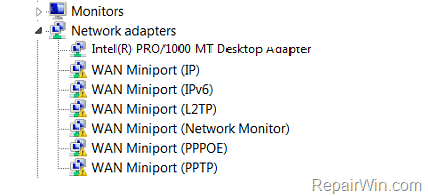
c. You see several Event log errors corresponding to the VPN Unavailable – Device missing problem. (e.g. “Remote Access Auto Connection Manager failed to start: Event ID 7001“, “Remote Access Connection Manager failed to start: Event ID: 20030, etc.).
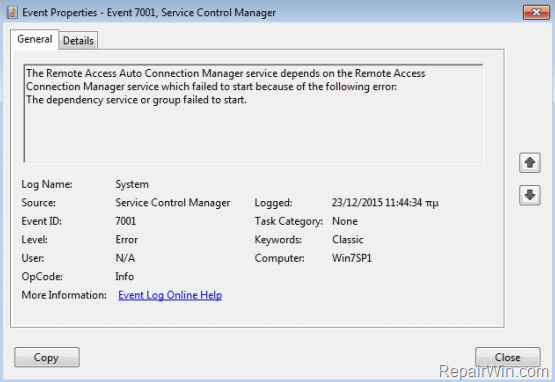
This tutorial contains detailed instructions to fix the VPN Connection “Unavailable – device missing” issue & the “Code 31” error on WAN Miniport adapter in Device manager (Windows 7 or 8 OS).
How to fix the VPN Connection “Unavailable – Device Missing” issue (Windows 7, 8 & 10).
Step-1. Scan your computer for Malware.
First, check your computer for malware infections by using this Malware Removal Guide. Then try to re-create your VPN connection. If the “VPN Unavailable – Device Missing” problem persists then continue to next step.
Step-2. Restart required VPN services.
1. Open Windows Services control panel: To do that:
- Press Windows
 + R keys to open the run command box.
+ R keys to open the run command box. - In the Search box, type: services.msc & click OK.

2. Make sure that the following services are exist and started.
1. Remote Access Auto Connection Manager.
2. Remote Access Connection Manager
3. Telephony
– If all the above services exists, try to restart them manually and then try to use your VPN connection. If the problem persists continue to Step-3.
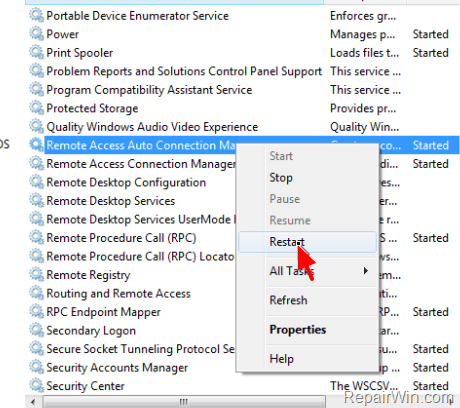
– If one or more of the above services are missing, then restore them by following the instructions on these posts, according your OS:
- How to Restore Default Services in Windows 7
- How to Restore Default Services in Windows 8 and 8.1
Step-3. Delete Real Time Event Trace Sessions Logs.
1. Start you computer in Safe Mode.
2. Log on to Windows by using an account with Administrative privileges.
3. Open Windows Explorer and navigate at the following location:
- C:WindowsSystem32LogFilesWMIRtBackup
4. Delete all the contents (“*.ETL” files) inside RtBackup folder.
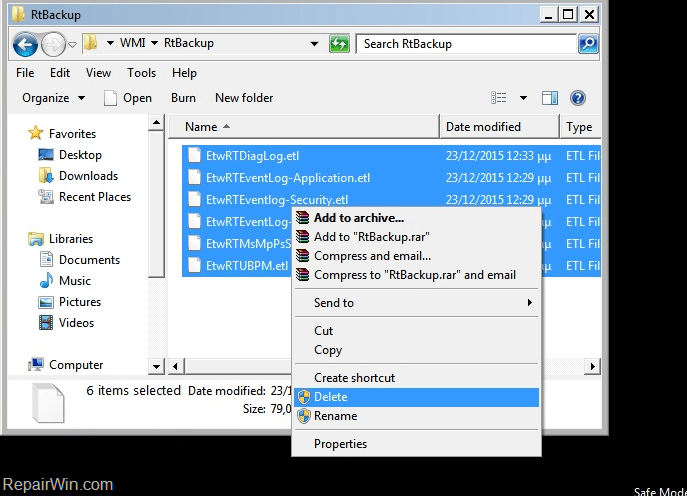
5. Restart your computer and log on to Windows normally.
6. Delete and re-create your VPN connection. If the problem persists, continue to Step-4.
Step-4. Check if the WAN miniport adapters are working properly.
1. Open Device Manager and expand Network Adapters.
If you see any WAN Miniport adapter with an yellow exclamation, that means that the WAN miniport adapter is not working properly. In this case you have to uninstall all problematic WAN miniport adapters.
To Uninstall a problematic WAN Miniport adapter.
1. Right-click on the non-working adapter and select Update Driver Software.
2. Then select Browse my computer for driver software.
3. Choose Let me pick from a list of device drivers on my computer.
4. Uncheck the Show compatible hardware checkbox.
5. From the Manufacturer list, choose Microsoft, and from the Network Adapter list, choose MAC Bridge Miniport or Bluetooth
Device (Personal Area Network) and then click Next.
6. Choose to install this driver software anyway.
7. After installation, go back to device manager but this time, right-click at the newly installed device (e.g. the “MAC Bridge Miniport“) and select Uninstall.
8. If you have several non working WAN miniport adapters in device manager, then you must uninstall all of them by performing the above procedure to each problematic WAN miniport device.
9. When done, with WAN Miniport uninstall, reboot your computer.
10. After restart, navigate to ‘Network and Sharing Center’ > ‘Change Adapter Settings’ and delete the existing non working VPN connection.
11. Create a new VPN connection and try to connect to your workplace. *
Note: If you still have problems with WAN Miniport adapter(s), then use this guide to completely remove and re-install WAN Miniport adapters on your system.
That’s all folks! Did it work for you?
Please leave a comment in the comment section below or even better: like and share this blog post in the social networks to help spread the word about this solution.

